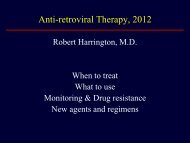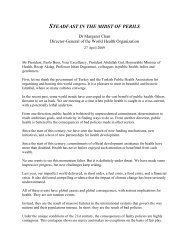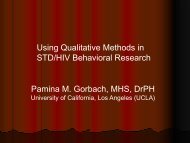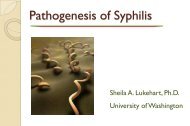The Evolution of HTA in Emerging Markets Health-Care ... - TREE
The Evolution of HTA in Emerging Markets Health-Care ... - TREE
The Evolution of HTA in Emerging Markets Health-Care ... - TREE
You also want an ePaper? Increase the reach of your titles
YUMPU automatically turns print PDFs into web optimized ePapers that Google loves.
OHE Consult<strong>in</strong>g Report for PhRMA<br />
5 January 2011<br />
<strong>of</strong> new health technologies, <strong>of</strong>ten by 2 years and at times 5 years (but no longer than that). To<br />
control the ris<strong>in</strong>g expenditures on pharmaceuticals, the BNHI has <strong>in</strong>troduced various strategies to<br />
control health expenditure <strong>in</strong>clud<strong>in</strong>g: <strong>in</strong>ternal reference pric<strong>in</strong>g (i.e., generic group<strong>in</strong>g based on the<br />
notion <strong>of</strong> ‘chemical equivalence’), external (<strong>in</strong>ternational) reference pric<strong>in</strong>g (based on prices <strong>of</strong><br />
products <strong>in</strong> ten <strong>in</strong>ternational reference countries), market price and volume surveys, and global<br />
budget payment for cl<strong>in</strong>ics and hospitals.<br />
A3.5 Pharmaceutical Distribution<br />
Those <strong>in</strong> Taiwan can get prescription drugs from a variety <strong>of</strong> sources <strong>in</strong>clud<strong>in</strong>g private cl<strong>in</strong>ics, state-licensed<br />
pharmacies, and general hospitals. Doctors are the primary prescribers although<br />
pharmacists can provide over-‐the-‐counter medications. <strong>The</strong>se medications range from traditional<br />
herbal remedies to modern western pharmaceuticals.<br />
S<strong>in</strong>ce the acquisition cost <strong>of</strong> the medication is almost always less than the reimbursement cost (from<br />
NHI), there is an <strong>in</strong>centive for hospitals and practitioners to overprescribe medications. In fact, a<br />
patient seldom leaves a visit to a doctor without a handful <strong>of</strong> prescription drugs. Of course, cultural<br />
factors and expectations probably play a large role <strong>in</strong> this as well. As noted above <strong>in</strong> Table 1, a large<br />
share <strong>of</strong> revenue from outpatients comes from drugs. As a result, there is an overuse <strong>of</strong> drugs,<br />
result<strong>in</strong>g <strong>in</strong> health problems, such as a high rate <strong>of</strong> immunity to antibiotics to those who need it.<br />
Hospitals are reimbursed by the BNH accord<strong>in</strong>g to the price list. Each hospital is reimbursed the by<br />
same amount for the same prescription. However, each hospital has its own acquisition cost<br />
through barga<strong>in</strong><strong>in</strong>g with the drug companies. Thus, larger hospitals, such as medical centres, with<br />
strong barga<strong>in</strong><strong>in</strong>g power are able to obta<strong>in</strong> drugs at a relatively low price.<br />
A3.6 Incorporation <strong>of</strong> New Drugs <strong>in</strong> the Taiwanese <strong>Health</strong> <strong>Care</strong><br />
System<br />
Figure 3 represents the relationship among the government bodies <strong>in</strong>volved <strong>in</strong> the drug review and<br />
<strong>HTA</strong> process (though the BPA was <strong>in</strong>tegrated <strong>in</strong>to the TFDA <strong>in</strong> January, 2010). <strong>The</strong> process for<br />
<strong>in</strong>troduc<strong>in</strong>g a new drug to the Taiwanese <strong>Health</strong> <strong>Care</strong> System is managed by the Drug Benefit<br />
Committee (DBC). It is comprised <strong>of</strong> experts from discipl<strong>in</strong>es <strong>in</strong>clud<strong>in</strong>g physicians, pharmacists, and<br />
economists; <strong>in</strong> total, there are 24 members (5 <strong>of</strong>ficers and 19 medical pr<strong>of</strong>essionals). Every month,<br />
the DBC meets to discuss applications for new drugs submitted by manufacturers, each <strong>of</strong> which is<br />
assigned to 2 <strong>of</strong> the 19 medical pr<strong>of</strong>essionals for review. With<strong>in</strong> 2 weeks, the medical pr<strong>of</strong>essionals<br />
assigned to the drug application submit a review for the rest <strong>of</strong> the committee to consider. <strong>The</strong><br />
entire committee then comes together 4 to 6 months later to discuss the proposed drug.<br />
When the M<strong>in</strong>ster <strong>of</strong> <strong>Health</strong> announced the upcom<strong>in</strong>g pilot program <strong>of</strong> evidence-‐based decision<br />
mak<strong>in</strong>g, he stressed that it would not prolong the process. A year later <strong>in</strong> 2008, a <strong>Health</strong> Technology<br />
Assessment (<strong>HTA</strong>) program was established <strong>in</strong> probationary form and the evaluation <strong>of</strong> drugs was to<br />
be accelerated to an average <strong>of</strong> 3 months. Apparently, the <strong>HTA</strong> team completes product evaluation<br />
<strong>in</strong> about 42 days, on average, while the review by DBC still takes longer than three months.<br />
99








